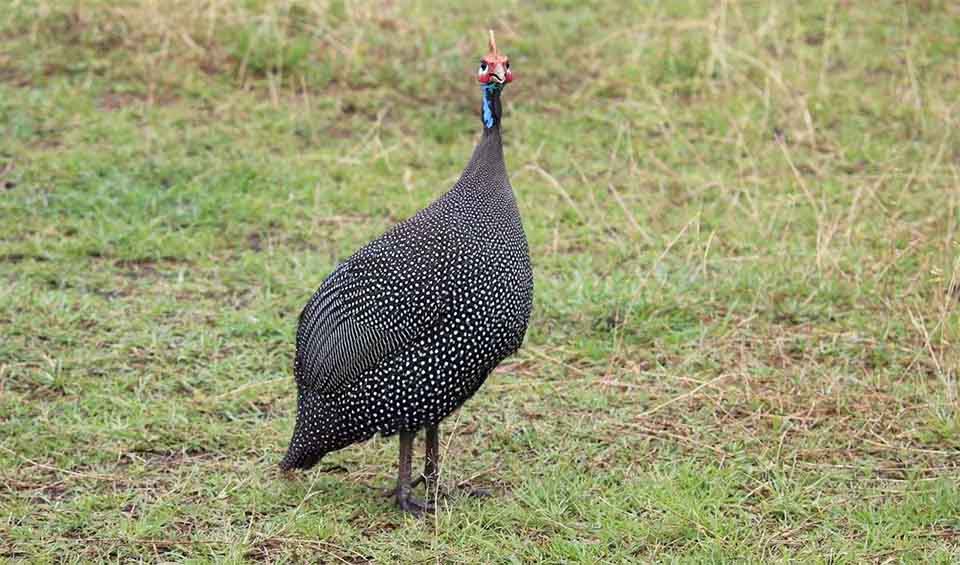A bird species native to Africa but has been widely domesticated and introduced into various parts of the world, such as Australia, North America, the West Indies, and Europe. These birds are known for their hardy nature and distinctive appearance, featuring a small head with a bony casque or ‘helmet,’ and a round body covered with grayish feathers with white spots, which makes them quite recognizable.
Helmeted guineafowl are terrestrial birds that spend most of their time on the ground. They are adept walkers and can cover distances up to 10 kilometers (about 6 miles) a day in search of food. Their strong legs are well-adapted for running, allowing them to quickly escape from predators. In fact, their ability to run at high speeds, along with their excellent vision, is one of their primary defense mechanisms.
Both male and female guineafowl are similar in size and plumage, making it difficult to distinguish between the sexes based on appearance alone. They exhibit a form of social behavior that involves living in flocks, which can range from a few birds to several hundred. These flocks provide safety in numbers, as individuals take turns watching for predators while others feed.
The Helmeted guineafowl plays an important role in controlling tick populations, as they consume large quantities of these arachnids. While this is generally beneficial for reducing tick-borne diseases like Lyme disease in humans and livestock, there is a misconception that guineafowl can spread the disease. In reality, they help control tick populations, which can reduce the incidence of such diseases.
Domestication of the Helmeted guineafowl has led to it becoming a common sight on farms and in backyards around the world. They are kept for their meat, which is a delicacy in some cultures, and for their eggs. In addition, they are valued for their pest control capabilities and are sometimes used as a natural method of reducing insect populations in agricultural settings.
Distribution
 Angola
Angola Antigua & Barbuda
Antigua & Barbuda Bahrain
Bahrain Benin
Benin Botswana
Botswana Burkina Faso
Burkina Faso Burundi
Burundi Cameroon
Cameroon Cape Verde
Cape Verde Central Af. Rep.
Central Af. Rep. Chad
Chad Comoros
Comoros Congo-Brazzaville
Congo-Brazzaville Cuba
Cuba Côte D’ivoire
Côte D’ivoire DR Congo (Kinshasa)
DR Congo (Kinshasa) Dominican Republic
Dominican Republic Equatorial Guinea
Equatorial Guinea Eritrea
Eritrea Eswatini
Eswatini Ethiopia
Ethiopia Gabon
Gabon Gambia
Gambia Ghana
Ghana Guinea-Bissau
Guinea-Bissau Guinea
Guinea Kenya
Kenya Lesotho
Lesotho Liberia
Liberia Madagascar
Madagascar Malawi
Malawi Mali
Mali Mauritania
Mauritania Mauritius
Mauritius Morocco
Morocco Mozambique
Mozambique Namibia
Namibia New Zealand
New Zealand Niger
Niger Nigeria
Nigeria Portugal
Portugal Puerto Rico
Puerto Rico Rwanda
Rwanda Saint Helena
Saint Helena Official estimate
Official estimate
 Saudi Arabia
Saudi Arabia Senegal
Senegal Sierra Leone
Sierra Leone Somalia
Somalia South Africa
South Africa South Sudan
South Sudan Spain
Spain St. Kitts & Nevis
St. Kitts & Nevis Sudan
Sudan Syria
Syria Official estimate
Official estimate
 São Tomé & Príncipe
São Tomé & Príncipe Tanzania
Tanzania Togo
Togo US Virgin Islands
US Virgin Islands Uganda
Uganda United States
United States Yemen
Yemen Zambia
Zambia Zimbabwe
ZimbabweAnything we've missed?
Help us improve this page by suggesting edits. Glory never dies!
Suggest an editGet to know me
Terrestrial / Aquatic
Altricial / Precocial
Polygamous / Monogamous
Dimorphic (size) / Monomorphic
Active: Diurnal / Nocturnal
Social behavior: Solitary / Pack / Herd / Flock
Diet: Carnivore / Herbivore / Omnivore / Piscivorous / Insectivore
Migratory: Yes / No
Domesticated: Yes / No
Dangerous: Yes / No





